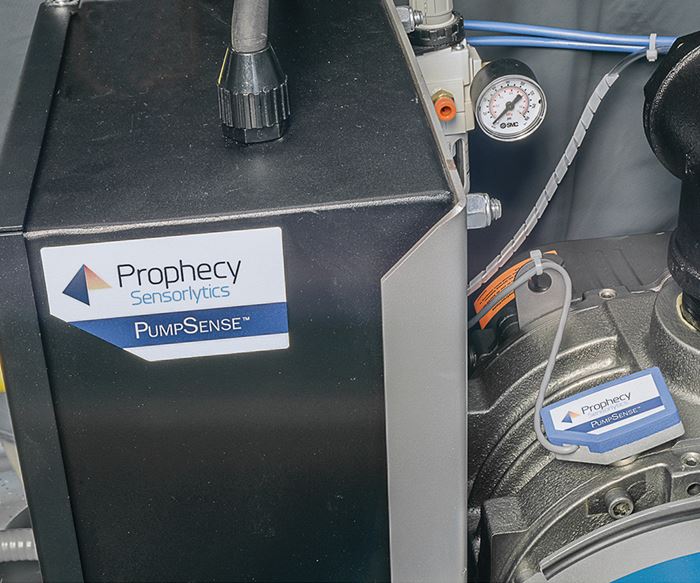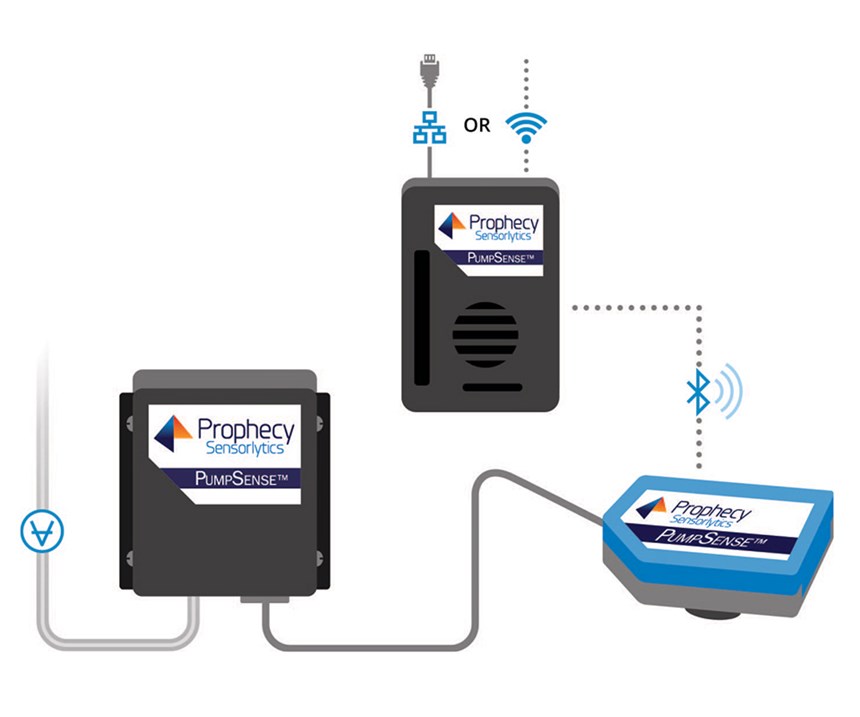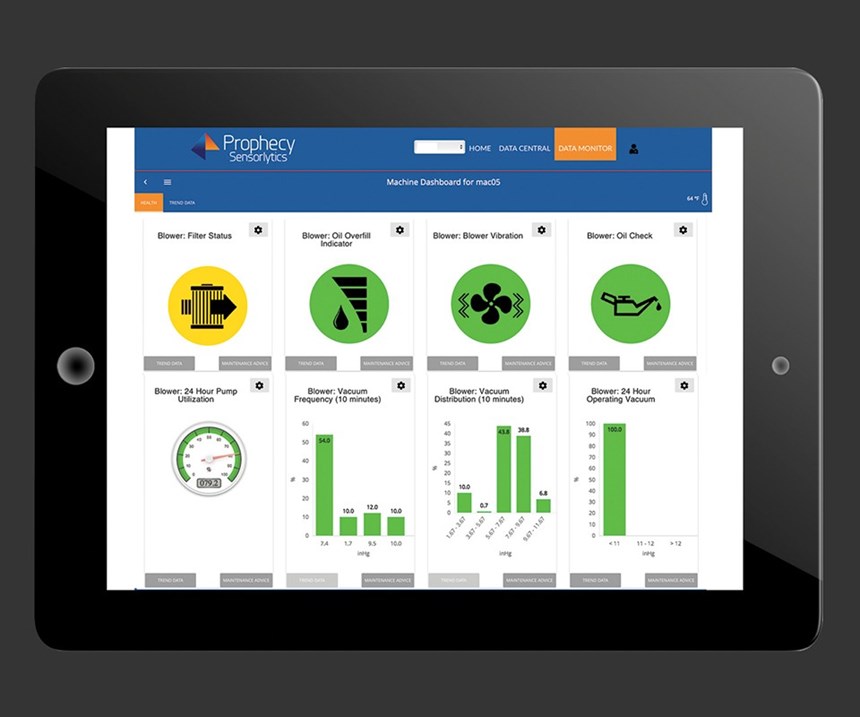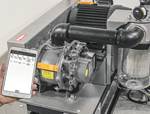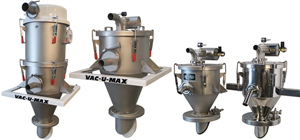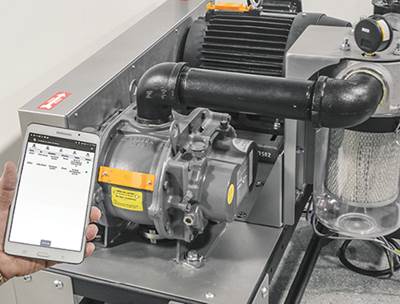‘Machine Wearables’ Predict Health of Vacuum Pumps & Blowers
Conveying systems now come with predictive-maintenance technology at no upcharge.
Novatec, Inc. is now offering vacuum-conveying systems equipped with “machine-wearable” sensor technology designed to predict pump and blower malfunction and failure. The technology is available on all new conveying systems as a result of a licensing arrangement between the supplier of auxiliary equipment and sister company Prophecy Sensorlytics. The two Baltimore-based companies debuted the predictive-maintenance technology at NPE2015 (see Feb. ’15 Close-Up), in what they termed a “soft start” to gauge processor and OEM interest. Since then, the machine wearables have been in beta testing at four processors, each of which retrofitted the sensor on existing machinery. One is an undisclosed injection molder that has been deploying the sensor on various conveying pumps and vacuum pumps used on its in-mold labeling (IML) system. Another has been at stretch-film processor J.C. Parry & Sons Inc. in Baltimore.
In the case of the molder, the Prophecy technology predicted pump failure days before the device actually went down, notes Steve Braig, a long-time plastics machinery executive who joined Prophecy as CEO last fall. Parry, meantime, uses sensors on vacuum-conveying pumps that feed material to its two 112-in.-wide cast stretch-film lines. “We don’t have redundancy in our manufacturing operation, and running at full capacity is critical,” states Daniel J. Parry, v.p. of R&D at the family-owned and operated firm. “Avoiding downtime is extremely important in our business.” Novatec is also testing the technology in its own manufacturing processes.
The Novatec new product launch is called PumpSense. There is no upcharge for processors that opt to equip their conveying system with the predictive-maintenance technology, says Conrad Bessemer, Novatec CEO. The technology package includes a free six-month data plan.
With PumpSense, Prophecy sensors are attached directly to the pump housing—using either screws or magnets—to constantly monitor a wide range of operating variables, including vacuum, vibration, temperature, pressure, sound, and magnetic field. A plug-in connection powers the sensor, unlike competitive units that rely on batteries. The data compiled by the sensor is transmitted to an easy-to-install gateway, and is then sent to cloud-based servers running Prophecy-developed analytic software.
Prophecy’s proprietary analytics algorithm tracks and compares the collected data against a baseline to deter- mine overall pump health. Filter status, oil status, pump utilization, and vacuum- or pressure-level trends are all constantly monitored. Results are transmitted from the server to smart devices via a user-friendly app, whereby plant managers can view the status of the machine in real time on a smart device. It can also be accessed over the internet via a PC. In either case, Prophecy software analyzes the data and generates “actionable advice” for plant managers on how to address any issues. Says Jim Zinski, Novatec’s v.p. of product technology, “We’re
giving plant management the tools it needs to organize any maintenance activities that are needed to prevent machine failure. This allows management to organize work flow and alert maintenance to problems that can be addressed before the machine goes down.”
The system self-learns, and users can adjust baseline performance expectations for their particular application, explains Dr. Biplab Pal, cofounder and chief technology officer of Prophecy Sensorlytics. The analytics compare conditions against baselines and send text and email messages with recommended maintenance solutions. “Dashboard” screens clearly display the condition of all monitored machine components, while a Maintenance, Repair, and Operations Screen displays a history of machine condition and records maintenance actions and assists.
Prophecy engineers will monitor data from installed systems to continually improve upon predictions, analytics, and future software updates available to customers. Prophecy has filed for 14 patents worldwide, Pal says.
CONDITION MONITORING VS. PM
The ability to provide “actionable advice” or “actionable intelligence” distinguishes the Prophecy technology from machine-wearable technology that other suppliers have introduced since NPE2015, Bessemer explains. “There is a big difference between condition monitoring and predictive maintenance. Pumps, for example, are typically furnished with only a local vacuum gauge. Controls can track motor faults and vacuum with costly sensors, etc., and alarm when something is wrong. That’s condition monitoring. But even condition monitoring has typically never been available for conveying pumps.
Lots of times, when the alarm sounds, the production people turn it off. With predictive-maintenance technology, on the other hand, analytics are used to establish an operating baseline, and the software predicts what is going to happen ... as opposed to reporting what did happen.”
Braig says the commercial launch of PumpSense is stage one of a two-stage process. In stage two, Prophecy will offer the technology for retrofit on pumps supplied by Novatec and other OEMs. (Only Novatec conveying pumps will offer the Prophecy sensor system as a standard.) PumpSense is the first of three product launches planned for this year. Still in beta testing are MachineSense, which will measure vibration, temperature, pressure, sound, and magnetic field of primary processing machinery (J.C. Parry & Sons is testing this technology to monitor motor health); and ElectroSense, which will monitor plant power and energy.
Related Content
Safety, Recycling, and Compounding Trends Bring New Opportunity to 70-Year-Old Company
NPE2024: Vac-U-Max presents pneumatic conveying solutions for powdered materials.
Read MoreBulk-Bag Filler Equipped with Pallet Dispenser
Between 14-16 pallets can be loaded for staging into the pallet dispenser.
Read MoreHow to Effectively Reduce Costs with Smart Auxiliaries Technology
As drying, blending and conveying technologies grow more sophisticated, they offer processors great opportunities to reduce cost through better energy efficiency, smaller equipment footprints, reduced scrap and quicker changeovers. Increased throughput and better utilization of primary processing equipment and manpower are the results.
Read MorePiovanGroup Announces Transition In Leadership In North America
John Erkert ascends to Regional CEO position for North America as industry veteran Kirk Winstead retires.
Read MoreRead Next
Detect When Equipment Needs Maintenance—Before It’s Too Late
New technology to debut next month at NPE warns when preventive maintenance is needed, before equipment failure disrupts production.
Read MoreBeyond Prototypes: 8 Ways the Plastics Industry Is Using 3D Printing
Plastics processors are finding applications for 3D printing around the plant and across the supply chain. Here are 8 examples to look for at NPE2024.
Read More

